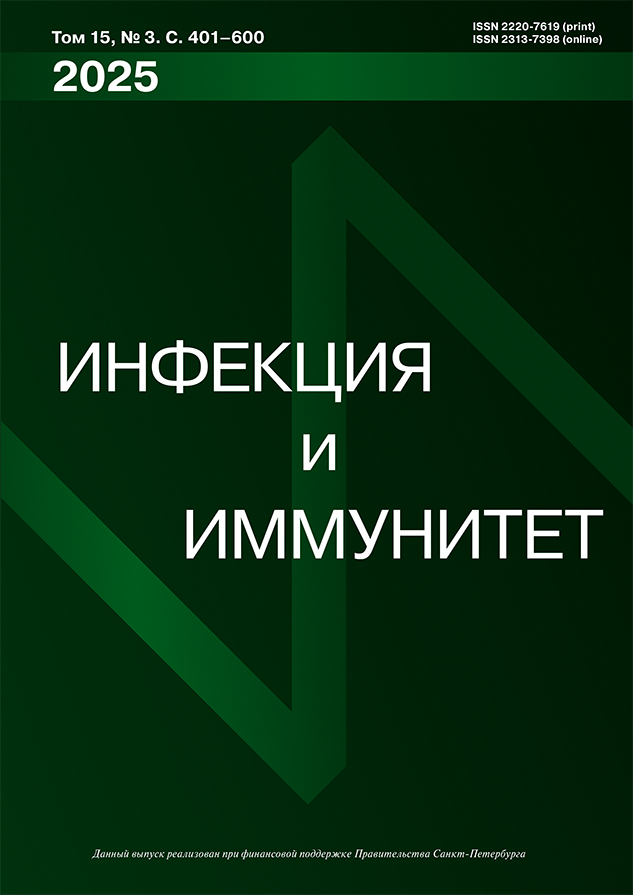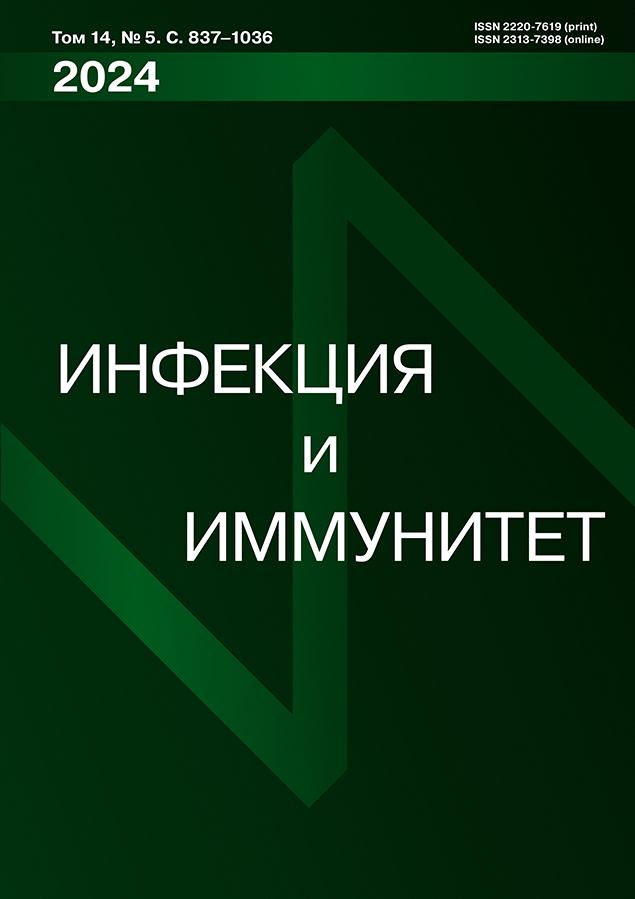Identification and determination of resistance to antimycotic factors in yeast clinical isolates during respiratory diseases
- Authors: Andreeva I.S.1, Morozova V.V.2, Kabanov A.S.1
-
Affiliations:
- State Research Center of Virology and Biotechnology “Vector”
- Institute of Chemical Biology and Fundamental Medicine, Siberian Branch of Russian Academy of Sciences
- Issue: Vol 14, No 5 (2024)
- Pages: 961-970
- Section: ORIGINAL ARTICLES
- Submitted: 05.04.2024
- Accepted: 13.08.2024
- Published: 21.12.2024
- URL: https://iimmun.ru/iimm/article/view/17630
- DOI: https://doi.org/10.15789/2220-7619-IAD-17630
- ID: 17630
Cite item
Full Text
Abstract
The prevalence of yeast infections has increased significantly over the past few decades, with resistance of isolated pathogens to antimicrobial agents becoming progressively more pressing. Commonly occurring pathogenic yeasts include genus Candida, with C. albicans species being the dominant in both superficial and invasive infectious processes. This report presents data on the identification and determination of antimycotic drug resistance for yeast isolates obtained from clinical material of a patient with chronic bronchitis and a patient with generalized fungal infection. As a result of genomic identification, the strain causing the generalized infection was identified as Candida utilis, confirming the literature data on its increasing prevalence, considered a rare pathogen of invasive processes, as a new dangerous pathogen. Antimycotic susceptibility testing revealed resistance of C. utilis strain to commonly used antifungal drugs such as ketoconazole, itraconazole and fluconazole, weak sensitivity to clotrimazole, nystatin and amphotericin B. The strain from a patient with chronic bronchitis was identified as C. africana, considered to be a C. albicans species. Excepting itraconazole, the strain showed varying sensitivity to the five antimycotic drugs used in the experiment. Both isolated yeast strains actively grew at elevated temperature, were able to form a capsule, hyphal sprouts and biofilms, features which distinguish potentially pathogenic Candida from saprotrophic strains. Combined antifungal therapy includes the use of probiotic preparations based on microorganisms that exhibit antagonism against fungi. The present work shows an effective inhibitory effect from secreted water-soluble metabolites of spore-forming bacteria Bacillus subtilis and Bacillus lichenformis, antiseptics “Octenisept” and “Chlorhexidine”, as well as rosemary and sandalwood oil extracts on growth activity of the studied pathogenic yeast strains and a typical control strain of C. albicans Y-583.
Full Text
About the authors
Irina S. Andreeva
State Research Center of Virology and Biotechnology “Vector”
Author for correspondence.
Email: andreeva_is@vector.nsc.ru
PhD (Biology), Associate Professor, Leading Researcher, Department of Biophysics and Ecological Research
Россия, Koltsovo, Novosibirsk RegionV. V. Morozova
Institute of Chemical Biology and Fundamental Medicine, Siberian Branch of Russian Academy of Sciences
Email: andreeva_is@vector.nsc.ru
PhD (Biology), Senior Researcher, Laboratory of Molecular Microbiology
Россия, NovosibirskA. S. Kabanov
State Research Center of Virology and Biotechnology “Vector”
Email: andreeva_is@vector.nsc.ru
PhD (Biology), Senior Researcher, Department of Microorganisms Collection
Россия, Koltsovo, Novosibirsk RegionReferences
- Бабьева И.П., Чернов И.Ю. Биология дрожжей // М.: Товарищество научных изданий КМК, 2004. 221 с. [Babieva I.P., Chernov I.Yu. Biology of yeast. Moscow: Partnership of Scientific Sditions of KMK, 2004, 221 с. (In Russ.)]
- Габриэлян Н.И., Горская Е.М., Крупенио Т.В., Зенкова В.А., Ефименко Т.А., Маланичева И.А., Сумарукова И.Г., Ефременкова О.В., Евлашкина В.Ф., Давыдов Д.С. Оценка антимикробной активности бациллярного пробиотика Bacillus subtilis (штамм 534) // Эпидемиология и инфекционные болезни. Актуальные вопросы. 2016. № 1. С. 41–47. [Gabrielyan N.I., Gorskaya E.M., Krupenio T.V., Zenkova V.A., Efimenko T.A., Malanicheva I.A., Sumarukova I.G., Efremenkova O.V., Evlashkina V.F., Davydov D.S. Evaluation of the antimicrobial activity of the bacterial probiotic Bacillus subtilis-534. Epidemiologiya i infektsionnye bolezni. Aktual’nye voprosy = Epidemiology and Infectious Diseases. Current Items, 2016, no. 1, pp. 41–47. (In Russ.)]
- Годовалов А.П., Быкова Л.П., Ожгибесов Г.П. Значение грибов рода Candida при воспалительных заболеваниях дыхательных путей // Сибирский медицинский журнал. 2008. № 7. С. 10–12. [Godovalov A.P., Bykova L.P., Ozhgibesov G.P. Significance of Candida in inflammatory diseases of respiratory tract. Sibirskij medicinskij zurnal = Siberian Medical Journal, 2008, no. 7, pp. 10–12. (In Russ.)]
- Капустина О.А., Карташова О.Л., Потехина Л.П., Уткина Т.М. Биопленкообразование Candida spp., выделенных из разных биотопов тела человека // Проблемы медицинской микологии. 2011. Т. 13, № 2. С. 81–82. [Kapustina O.A., Kartashova O.L., Potekhina L.P., Utkina T.M. Biofilm formation of Candida isolated from different human’s biotopes. Problemy meditsinskoi mikologii = Problems of Medical Mycology, 2011, vol. 13, no. 2, pp. 81–82. (In Russ.)]
- Кольцов И.П., Стрельникова Н.В., Витько Е.В., Витько Л.Г., Савлюк О.Е. Микробиологические свойства условно-патогенных сахаромицетов рода Candida при хронических, рецидивирующих инфекционно-воспалительных процессах (обзор литературы) // Тихоокеанский медицинский журнал. 2023. № 1. С. 19–26. [Koltsov I.P., Strelnikova N.V., Vitko E.V., Vitko L.G., Savlyuk O.E. Microbiological properties of opportunistic saccharomycetes of the genus Candida in chronic, recurrent infectious inflammatory processes (literature review). Tihookeanskiy medicinskiy zhurnal = Pacific Medical Journal, 2023, no. 1, pp. 19–26. (In Russ.)] doi: 10.34215/1609-1175-2023-1-19-26
- Лыков И.Н., Викторова А.С., Муравьева А.С., Петелина К.О. Скрининг эфирных масел на предмет их антимикробной активности // Международный научно-исследовательский журнал. 2023. № 8 (110), Часть 2. С. 19–23. [Lykov I.N., Viktorova A.S., Muravyeva A.S., Petelina K.O. Screening of essential oils for their antimicrobial activity. Mezhdunarodnyi nauchno-issledovatel’skii zhurnal = International Research Journal, 2023, no. 8 (110), part 2, pp. 19–23. (In Russ.)] doi: 10.23670/IRJ.2021.110.8.039
- Маланичева И.А., Козлов Д.Г., Ефименко Т.А., Зенкова В.А., Катруха Г.С., Резникова М.И., Королев А.М., Борщевская Л.Н., Тарасова О.Д., Синеокий С.П., Ефременкова О.В. Новые антибиотики, образуемые штаммами Bacillus subtilis // Микробиология. 2014. Т. 83, № 5. С. 445–450. [Malanicheva I.A., Kozlov D.G., Efimenko T.A., Zenkova V.A., Katrukha G.S., Reznikova M.I., Korolev A.M., Borshchevskaya L.N., Tarasova O.D., Sineokii S.P., Efremenkova O.V. New antibiotics produced by Bacillus subtilis strains. Mikrobiologiya = Mikrobiologiya, 2014, vol. 83, no. 4, pp. 445–450. (In Russ.)] doi: 10.7868/S0026365614040119
- МУК 4.2.1890-04 Определение чувствительности микроорганизмов к антибактериальным препаратам: Методические указания. М.: Федеральный центр госсанэпиднадзора Минздрава России, 2004. 91 с. [MUK 4.2.1890-04 Determination of sensitivity of microorganisms to antibacterial drugs: Methodical instructions. Moscow: Federal Center of Gossanepidnadzor of the Ministry of Health of Russia, 2004. 91 p. (In Russ.)]
- Николаева Е.Н. Частота встречаемости в полости рта дрожжеподобных грибов рода Candida при остром респираторном заболевании // Международный научно-исследовательский журнал. 2013. № 5. С. 69–70. [Nikolaeva E.N. The frequency of occurrence in the mouth yeast-like fungi of the genus Candida with acute respiratory diseases. Mezhdunarodnyi nauchno-issledovatel’skii zhurnal = International Research Journal, 2013, vol. 12, no. 5, pp. 69–70. (In Russ.)] https://elibrary.ru/item.asp?id=19077906
- Саттон Д., Фотергилл А., Ринальди М. Определитель патогенных и условно патогенных грибов. М.: Мир, 2001. 468 с. [Sutton D., Fothergill A., Rinaldi M. The determination of pathogenic and conditionally pathogenic fungi. Moscow: Mir, 2001. 468 p. (In Russ.)]
- Сачивкина Н.П., Ленченко Е.М. Эффективные способы идентификации дрожжеподобных грибов рода Candida // Ветеринария. 2019. № 2. С. 25–28. [Sachivkina N.P., Lenchenko E.M. Effective ways to identify yeast-lice fungi of the genus Candida. Veterinariya = Veterinary Medicine, 2019, no. 2, pp. 25–28. (In Russ.)] doi: 10.30896/0042-4846.2019.22.2.25-28
- Сергеев А.Ю., Сергеев Ю.Б. Кандидоз. Природа инфекции, механизмы агрессии и защиты, лабораторная диагностика, клиника и лечение. М.: Триада, 2001. 472 с. [Sergeev A.Yu., Sergeev Yu.B. Candidiasis. Nature of infection, mechanisms of aggression and protection, laboratory diagnosis, clinic and treatment. Moscow: Triada, 2001, 472 p. (In Russ.)]
- Шаповал О.Г., Шереметьева А.С., Дурнова Н.А., Мухамадиев Н.К., Раббимова Г.Т., Назирбеков М.Х. Антимикробная активность эфирных масел Thymus serpyllum L. и Thymus marschallianus Willd. в отношении Candida albicans // Химико-фармацевтический журнал. 2023. Т. 57, № 9. С. 26–31. [Shapoval O.G., Sheremetyeva A.S., Durnova N.A., Mukhamadiev N.Q., Rabbimova G.T., Nazirbekov M.K. Antimicrobial activity of essential oils of Thymus serpyllum L. and Thymus marschallianus Willd. against Candida albicans. Khimiko-farmatsevticheskii zhurnal = Chemical and Pharmaceutical Journal, 2023, vol. 57, no. 9, pp. 26–31. (In Russ.)] doi: 10.30906/0023-1134-2023-57-9-26-31
- Borman A.M., Szekely A., Linton C.J., Palmer M.D., Brown Ph., Johnson E.M. Epidemiology, antifungal susceptibility, and pathogenicity of Candida africana isolates from the United Kingdom. J. Clin. Microbiol., 2013, vol. 51, no. 3, pp. 967–972. doi: 10.1016/j.heliyon.2020.e03619
- Cannon R.D., Holmes A.R., Mason A.B., Monk B.C. Oral candida: clearance, colonization, or candidiasis? J. Dent. Res., 1995, vol. 74, no. 5, pp. 1152–1161. doi: 10.1177/00220345950740050301
- Cavalheiro M., Teixeira M.C. Candida biofilms: threats, challenges, and promising strategies. Front. Med. (Lausanne), 2018, vol. 5: 28. doi: 10.3389/fmed.2018. 00028
- Cortegiani A., Misseri G., Fasciana T., Giammanco A., Giarratano A., Chowdhary A. Epidemiology, clinical characteristics, resistance, and treatment of infections by Candida auris. J. Intensive Care, 2018, vol. 6: 69. doi: 10.1186/s40560-018-0342-4
- Gardes M., Bruns T.D. ITS primers with enhanced specificity for basidiomycetes – application to the identification of mycorrhizae and rusts. Molecular Ecology, 2008, vol. 2, no. 2, pp. 113–118. doi: 10.1111/j.1365-294x.1993.tb00005.x
- Gow N.A.R., Yadav B. Microbe Profile: Candida albicans: a shape-changing, opportunistic pathogenic fungus of humans. Microbiology, 2017, vol. 163, no. 8, pp. 1145–1147. doi: 10.1099/mic.0.000499
- Jindal N., Arora S., Dhuria N., Arora D. Cyberlindnera (Pichia) fabianii infection in a neutropenic child: importance of molecular identification. J. Med. Microbiol. Case Reports, 2015, vol. 2, no. 4, pp. 1–3. doi: 10.1099/jmmcr.0.000033
- Lukić-Grlić A., Mlinarić-Missoni E., Škarić I., Važić-Babić V., Svetec I.-K. Candida utilis candidaemia in neonatal patients. J. Med. Microbiol., 2011, vol. 60, no. 6, pp. 838–841. doi: 10.1099/jmm.0.023408-0
- Mayer F.L., Wilson D., Hube B. Candida albicans pathogenicity mechanisms. Virulence, 2013, vol. 4, no. 2, pp. 119–128. doi: 10.4161/viru.22913
- Ostrosky-Zeichner L., Al-Obaidi M. Invasive fungal infections in the intensive care unit. Infect. Dis. Clin. North Am., 2017, vol. 31, no. 3, pp. 475–487. doi: 10.1016/j.idc. 2017.05.005
- Sahal G., Bilkay I.S. Distribution of clinical isolates of Candida spp. and antifungal susceptibility of high biofilm-forming Candida isolates. Rev. Soc. Bras. Med. Trop., 2018, vol. 51, no. 5, pp. 644–650. doi: 10.1590/0037-8682-0136-2018
- Welsh R.M., Bentz M.L., Shams A., Houston H., Lyons A., Rose L.J., Livintseva A.P. Survival, persistence, and isolation of the emerging multidrug-resistant pathogenic yeast Candida auris on a plastic health care surface. J. Clin. Microbiol., 2017, vol. 55, no. 10, pp. 2996–3005. doi: 10.1128/JCM.00921-17
- Sherwood J., Gow N.A., Gooday G.W., Gregory D.W., Marshall D. Contact sensing in Candida albicans: a possible aid to epithelial penetration. J. Med. Vet. Mycol., 1992, vol. 30, no. 6, pp. 461–469. doi: 10.1080/02681219280000621
- Shih M.H., Sheu M.M., Chen H.Y., Lin S.R. Fungal keratitis caused by Candida utilis – case report. Kaohsiung J. Med. Sci., 1999, vol. 15, no. 3, pp. 171–174.
- Sreelekshmi T.S., Ninan M.M., Premanand A., Chacko A., Sahni R.D., Michael J.S. Candida utilis: a rare cause of septicemia in children. Access Microbiology, 2021, vol. 3, no. 10: 000281. doi: 10.1099/acmi.0.000281
- Treguier P., David M., Gargala G., Camus V., Stamatoullas A., Menard A.-L., Lenain P., Contentin N., Lemasle E., Lanic H., Tilly H., Jardin F., Lepretre S. Cyberlindnera jadinii (teleomorph Candida utilis) candidaemia in a patient with aplastic anaemia: a case report. JMM Case Rep., 2018, vol. 5, no. 8: e005160. doi: 10.1099/jmmcr.0.00516
Supplementary files














